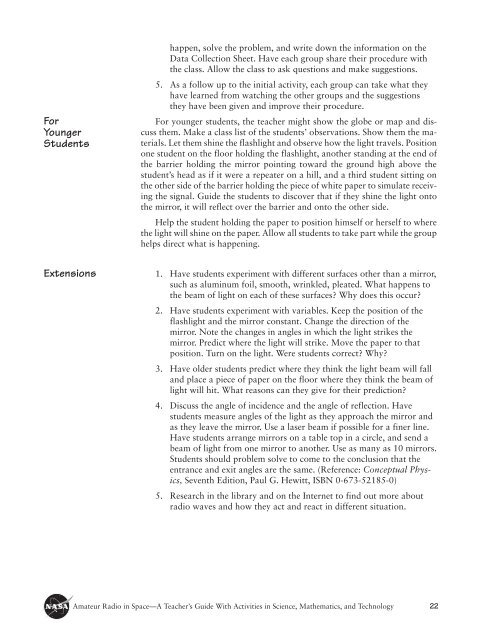When look<strong>in</strong>g at a relief map of the Earth, one cannot help but notice thatEarth is not a flat pla<strong>in</strong>. There are many valleys and mounta<strong>in</strong> ranges. Whenstand<strong>in</strong>g on an ocean shorel<strong>in</strong>e, Earth appears flat. But we know that Earth isround. Pictures sent from satellites and orbit<strong>in</strong>g spacecraft have allowed us tosee our round Earth. S<strong>in</strong>ce radio waves travel <strong>in</strong> a straight l<strong>in</strong>e, how then canwe send a signal to the other side of a barrier and beyond? Some radio signals,called direct waves, travel <strong>in</strong> a straight direction or l<strong>in</strong>e-of-sight. These signalscannot bend or “jump” over a barrier such as a hill or mounta<strong>in</strong> range. Theyare also unable to curve around Earth. The signal from a radio on one side ofthe hill is transmitted to the other side by a repeater positioned on the top ofthe barrier. A repeater receives a signal on one frequency and simultaneouslysends, or re-transmits (repeats) it on another frequency to a radio on the otherside of the barrier thereby extend<strong>in</strong>g the range of the re-transmitted signals.The frequency it receives on is the <strong>in</strong>put frequency, and the frequency it transmitson is the output frequency. Often located atop a tall build<strong>in</strong>g or highmounta<strong>in</strong>, VHF and UHF repeaters greatly extend the operat<strong>in</strong>g range of<strong>Amateur</strong> <strong>Radio</strong> operators us<strong>in</strong>g mobile and hand-held transceivers. When atransmitter and receiver are comb<strong>in</strong>ed <strong>in</strong>to one box, it becomes a transceiverand can send and receive signals. If a repeater serves an area, it’s not necessaryfor everyone to live on a hilltop. But you have to be able to hear the repeater’stransmitter and reach the repeater’s receiver with your transmitted signal.BackgroundInformation1. Share background <strong>in</strong>formation with students. Show globe or reliefmap of Earth. Have students write or draw their observations ofEarth on the Data Sheet. Discuss these observations orally.2. Gather students together around a barrier (chair, desk, etc.) Expla<strong>in</strong>to students that the barrier represents a very tall hill or mounta<strong>in</strong>range.3. Show flashlight, mirror, and piece of paper. Discuss the properties ofeach, how they are used <strong>in</strong> our daily lives, and any prior knowledgestudents may have about light beams and how they travel. Theflashlight beam represents radio waves, the mirror represents therepeater on top of a hill, and the piece of paper represents the radioon the other side.HINT: Cover the flashlight with a piece of paper that has a small, verticalslit cut <strong>in</strong> the middle. This will create a narrower light beam.Discuss vocabulary words and have students write def<strong>in</strong>itions tothose words on the Data Collection Sheet.4. Tell students they will work <strong>in</strong> teams of four. The problem they mustsolve is to devise a way to send a beam of light to the other side ofthe barrier go<strong>in</strong>g over the top of the barrier. The light must travelfrom the flashlight held touch<strong>in</strong>g the floor on one side of the barrierto the piece of paper placed on the floor on the other side of thebarrier. Rem<strong>in</strong>d them that they must go over the barrier. They willneed to document the steps they take <strong>in</strong> the Data Collection Sheet.After a group discussion, make sure students understand the task.Give ample time for students to work <strong>in</strong> their groups to write theproblem to be solved, discuss and predict what they th<strong>in</strong>k willLet’s Beg<strong>in</strong>21 <strong>Amateur</strong> <strong>Radio</strong> <strong>in</strong> <strong>Space</strong>—A Teacher’s Guide With Activities <strong>in</strong> Science, Mathematics, and Technology
ForYoungerStudentshappen, solve the problem, and write down the <strong>in</strong>formation on theData Collection Sheet. Have each group share their procedure withthe class. Allow the class to ask questions and make suggestions.5. As a follow up to the <strong>in</strong>itial activity, each group can take what theyhave learned from watch<strong>in</strong>g the other groups and the suggestionsthey have been given and improve their procedure.For younger students, the teacher might show the globe or map and discussthem. Make a class list of the students’ observations. Show them the materials.Let them sh<strong>in</strong>e the flashlight and observe how the light travels. Positionone student on the floor hold<strong>in</strong>g the flashlight, another stand<strong>in</strong>g at the end ofthe barrier hold<strong>in</strong>g the mirror po<strong>in</strong>t<strong>in</strong>g toward the ground high above thestudent’s head as if it were a repeater on a hill, and a third student sitt<strong>in</strong>g onthe other side of the barrier hold<strong>in</strong>g the piece of white paper to simulate receiv<strong>in</strong>gthe signal. Guide the students to discover that if they sh<strong>in</strong>e the light ontothe mirror, it will reflect over the barrier and onto the other side.Help the student hold<strong>in</strong>g the paper to position himself or herself to wherethe light will sh<strong>in</strong>e on the paper. Allow all students to take part while the grouphelps direct what is happen<strong>in</strong>g.Extensions1. Have students experiment with different surfaces other than a mirror,such as alum<strong>in</strong>um foil, smooth, wr<strong>in</strong>kled, pleated. What happens tothe beam of light on each of these surfaces? Why does this occur?2. Have students experiment with variables. Keep the position of theflashlight and the mirror constant. Change the direction of themirror. Note the changes <strong>in</strong> angles <strong>in</strong> which the light strikes themirror. Predict where the light will strike. Move the paper to thatposition. Turn on the light. Were students correct? Why?3. Have older students predict where they th<strong>in</strong>k the light beam will falland place a piece of paper on the floor where they th<strong>in</strong>k the beam oflight will hit. What reasons can they give for their prediction?4. Discuss the angle of <strong>in</strong>cidence and the angle of reflection. Havestudents measure angles of the light as they approach the mirror andas they leave the mirror. Use a laser beam if possible for a f<strong>in</strong>er l<strong>in</strong>e.Have students arrange mirrors on a table top <strong>in</strong> a circle, and send abeam of light from one mirror to another. Use as many as 10 mirrors.Students should problem solve to come to the conclusion that theentrance and exit angles are the same. (Reference: Conceptual Physics,Seventh Edition, Paul G. Hewitt, ISBN 0-673-52185-0)5. Research <strong>in</strong> the library and on the Internet to f<strong>in</strong>d out more aboutradio waves and how they act and react <strong>in</strong> different situation.<strong>Amateur</strong> <strong>Radio</strong> <strong>in</strong> <strong>Space</strong>—A Teacher’s Guide With Activities <strong>in</strong> Science, Mathematics, and Technology 22
















